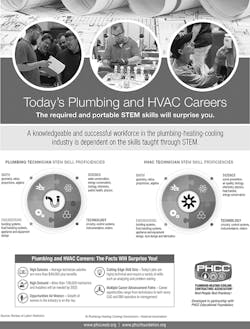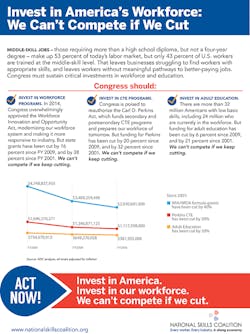Workforce development is a broad term for the various methods businesses, communities, state and local governments, and organizations use to teach the skills people need to get a job and be successful. The concept has evolved to match the skills of individuals to the specific needs of U.S. industries and businesses.
In the plumbing-heating-cooling industry, the skills gap is a significant obstacle for many contractors, distributors and manufacturers, and has been for decades. Without enough workers trained and certified to maintain, repair and replace today’s highly technical plumbing, heating and air-conditioning equipment, many industry entities are unable to thrive and grow. Investment in new construction projects peaked at more than $1 billion in November 2017, and everyone in the construction industry is feeling the pain of the labor shortage and skills gap.
The stigma of blue-collar jobs still exists in 2018 as parents, high-school guidance counselors and college administrators continue to push the idea that a university education is the only secondary education needed to secure a high-paying job. The once-prevalent vocational schools found in small towns and rural counties have almost disappeared. Subsequently, students who may not be good candidates for college — who are more mechanically inclined or interested in how things work — are pressured into taking on enormous debt for a degree or career they may not be interested in.
But positive change is happening, albeit slowly. Charter schools have tried to bridge the gap with architecture, engineering and construction charter schools forming to teach young people the construction trades. In addition, Congress recently reauthorized the Carl D. Perkins Career and Technical Education Act, which approves more $1 billion each year for states to fund vocational and career-focused education programs.
Funding for these programs is a crucial issue; many times national, state and local governments reduce or eliminate these programs when they have a budget shortfall. Yet these types of job-training programs are critically needed to get people working in occupations that are in desperate need of workers.
“Part of the funding problem is that available resources tend to cover only the direct operating costs of a training program, and nothing more,” writes Maureen Conway, vice president for policy programs and executive director of the Aspen Institute’s Economic Opportunities Program, in a Fast Company article. “Instead, we also have to be willing to support the participants of job-training initiatives, who have real costs to bear outside of the training coursework itself. Learning takes people away from existing work, even if their jobs are low-paid. They often still have rent to pay and family members to take care of.
“Successful job training programs need to factor these costs into their funding projections, or at least offer adequate resources to connect participants with other organizations that can help with childcare, housing, transportation, food and other basics.”
Television personality Mike Rowe, well-known for his programs “Dirty Jobs” and “Somebody’s Got to Do It,” is a staunch defender of men and women who work in the trades. He has helped elevate the conversation about trades careers. His mikeroweWORKS Foundation (http://profoundlydisconnected.com) provides “financial assistance to qualified individuals with a desire to learn a skill that is in demand,” the website notes. “The foundation has been instrumental in granting more than $3 million in education for trade schools across the country.”
What you see in the next few pages are some of the workforce development resources available to trades businesses to recruit and train the next generation of plumbing and heating contractors. It is by no means exhaustive; if you know of a program or resource not listed, contact the editors and we’ll add it to the list.
PHC association resources
The PHC industry has spent much time and money over the last couple decades to raise the level of professionalism in the industry, thereby trying to make the PHC trades more attractive to high-school students and their parents.
Many industry groups focus attention on providing members with the best practices they need to differentiate their businesses from competitors. They, too, have looked at how to attract the right people to the industry.
• Plumbing-Heating-Cooling Contractors — National Association Workforce Development Center (www.phccweb.org/workforce). Includes career videos, “Earn While You Learn” posters and ads, success stories, information on pre-apprenticeship programs, and tips on recruiting resources such as Career Days.
The PHCC Career Center is for members to post available jobs or to look for jobs. The PHC careers website (www.phccareers.com) is geared toward students looking at possible trades careers. The site includes information on scholarships through the PHCC Educational Foundation, apprentice training and connecting with local and state chapters.
• Mechanical Contractors Association of America Great Futures website (https://mcaagreatfutures.org). This site grew out of the MCAA Student Chapter initiative at more than 50 colleges and universities across the country. Potential employers can look at student resumes, and students have access to news and resources to learn more about the industry.
• Nexstar Foundation Explore the Trades program (https://explorethetrades.org). A key feature of this program for the plumbing, HVAC and electrical trades is the Personal Guide Program, where a successful person in the trades will mentor anyone interested in a trades career by sharing experiences and answering questions. Information on scholarships and apprenticeships is also available.
What other contractors are doing
Many contractors have taken it upon themselves to “grow their own” apprentices and technicians by implementing training/recruitment programs or starting their own training schools. Others are working with community organizations to recruit people into their companies.
• TDIndustries’ THRIVE program. In the pilot program, which concluded in May, TDIndustries partnered with the United Way and hired 10 of its workers to teach sheet-metal production. Program participants spent the first few weeks in training but then worked at a Houston jobsite. The program has widened access to female applicants and has sparked another similar program in the company’s Arizona branch. Other locations are working to make it possible.
"When brainstorming solutions in 2016, we had a shift in mindset: We were always going to operate in a deficit so long as we were only recruiting 50 percent of the population," says Randee Herrin, senior vice president of Houston new construction and who came up with the idea for TD. "We realized that if we shifted our focus to the training and development of women, we could create a pipeline of talent that could lead us out of deficit and into abundance."
• Atomic Plumbing’s apprenticeship program (www.atomicplumbing.com). Owner Jim Steinle pays for his apprentices to go to school and become journeymen plumbers. He gives apprentices a detailed career path so they know they can stay with the company in a lucrative career.
• S & D Plumbing’s Plumbing Pipeline Program (www.sanddplumbing.com). Founder Sam Dowdy Sr. started the program to teach young people the plumbing trade — evenings, weekends, summers. In return, after graduating high school, students would get a full-time job at the company and a scholarship for apprenticeship training. That morphed into working with the state PHCC organization and the Texas State Technical College to provide a curriculum for high-school students to learn plumbing.
• Hiller Plumbing, Heating, Cooling and Electrical’s Total Tech school (www.totaltechschool.com). Owner Jimmy Hiller got so frustrated trying to find qualified workers for his company that he bought out the owner of the school that he sent his techs to for training. The school teaches HVAC and plumbing; a full-time recruiter works with area high schools to make sure the school is at trade fairs and career days. Students spend one month in class and three months on various jobsites.
Transitioning veterans
Veterans leaving the military are sought-after employees in the PHC trades. They are used to processes and procedures, working hard and being on time. These groups can help contractors recruit and hire veterans for their businesses.
• Nexstar Foundation’s Troops to Trades (https://explorethetrades.org/troops-to-trades). The foundation offers scholarships and training opportunities to individuals who have dedicated parts of their lives to the armed services for the United States and are interested in learning a technical trade. All scholarship cover costs of training, travel and food and lodging.
• Hiller Plumbing, Heating, Cooling and Electrical’s Transition to Trades (http://transitiontotrades.happyhiller.com). This program is an approved Career Skills Program developed by Hiller Plumbing and U.S. Army Garrison, Fort Campbell. It allows separating soldiers the opportunity to attend the Total Tech trade school to learn valuable technical career skills while remaining active duty in the U.S. Army.
• United Association’s Veterans in Piping program (www.uavip.org/veterans). The UA established the Veterans in Piping program to equip military service members preparing to leave the service with sought-after skills that can lead to lifelong careers in the in-demand pipe trades. Through 18-week accelerated courses — provided free of cost on military bases across the country — VIP participants earn industry-recognized certifications and direct entry into solid private-sector jobs with good pay and benefits.
Government resources
Just about every state has a workforce development program for its residents. The listing below is only a partial listing; if your state isn’t listed here, Google workforce development and your state, or contact your state’s labor department.
• Hawaii Workforce Development Division (https://labor.hawaii.gov/wdd)
• Illinois Department of Commerce and Economic Opportunity (www.illinois.gov/dceo/Pages/default.aspx)
• Indiana Department of Workforce Development (https://secure.in.gov/dwd/)
• Iowa Workforce Development (www.iowaworkforcedevelopment.gov)
• Louisiana Workforce Commission (www.laworks.net)
• Maryland Division of Workforce Development and Adult Learning (www.dllr.state.md.us/employment)
• Michigan Workforce Development Agency (www.michigan.gov/wda)
• Nebraska Department of Labor (https://dol.nebraska.gov)
• North Dakota Workforce Development (www.workforce.nd.gov)
• Ohio Office of Workforce Development (https://jfs.ohio.gov/owd)
• Pennsylvania Department of Labor & Industry's Workforce Development (www.dli.pa.gov/Businesses/Workforce-Development/Pages/default.aspx)
• Texas Workforce Commission (https://twc.texas.gov)
• Utah Department of Workforce Services (https://jobs.utah.gov)
• Wisconsin Department of Workforce Development (https://dwd.wisconsin.gov)
About the Author

Kelly L. Faloon
Freelance Writer/Editor
Kelly L. Faloon is a contributing editor and writer to Contractor, Contracting Business magazine and HPAC Engineering and principal of Faloon Editorial Services. The former editor of Plumbing & Mechanical magazine, Faloon has more than 26 years of experience in the plumbing and heating industry and more than 35 years in B2B publishing. She started a freelance writing and editing business in 2017, where she has a varied clientele.
Faloon spent 3 1/2 years at Supply House Times before joining the Plumbing & Mechanical staff in 2001. Previously, she spent nearly 10 years at CCH/Wolters Kluwer, a publishing firm specializing in business and tax law, where she wore many hats — proofreader, writer/editor for a daily tax publication, and Internal Revenue Code editor.
A native of Michigan’s northern Lower Peninsula, Faloon is a journalism graduate of Michigan State University. You can reach her at [email protected].





